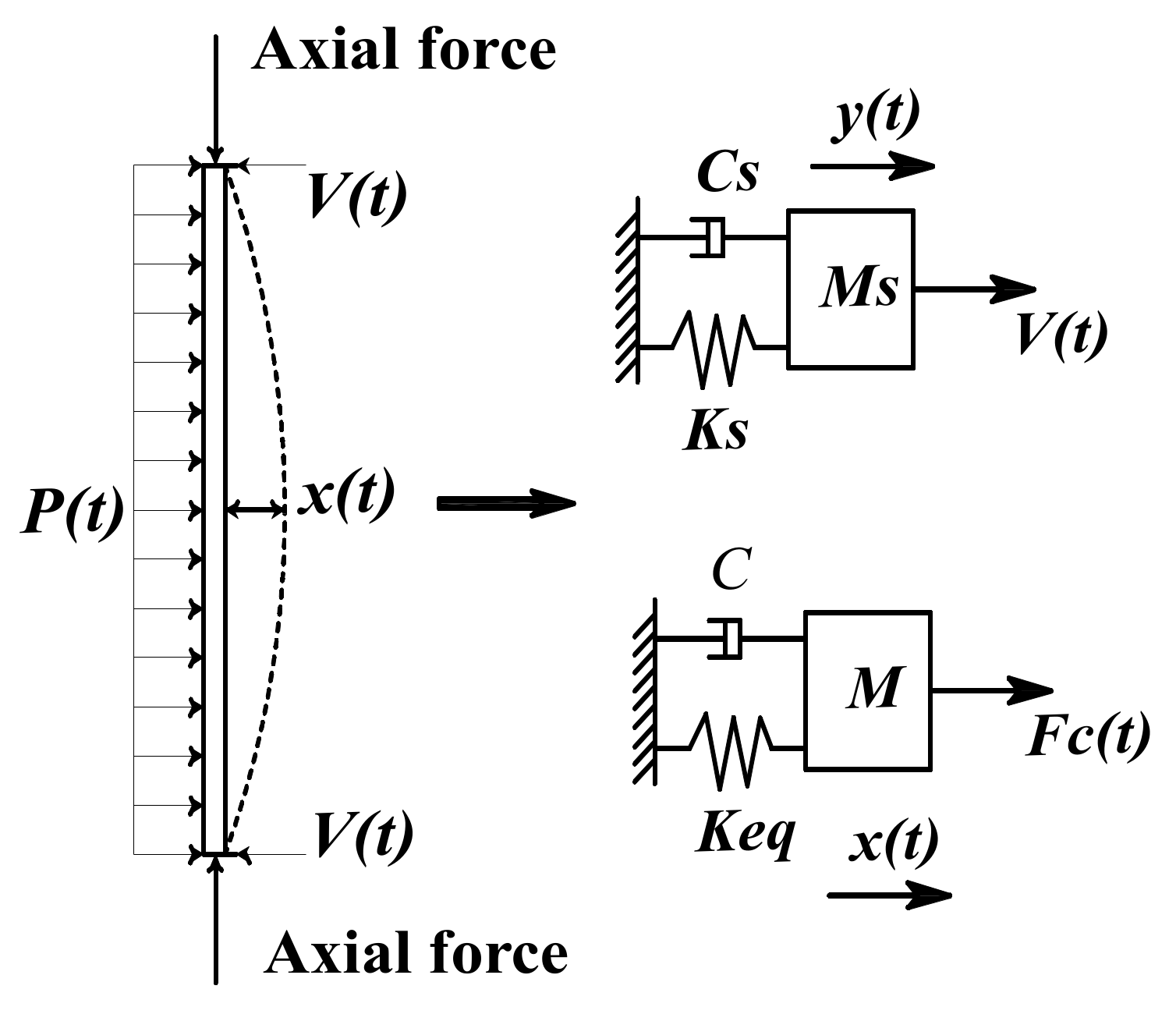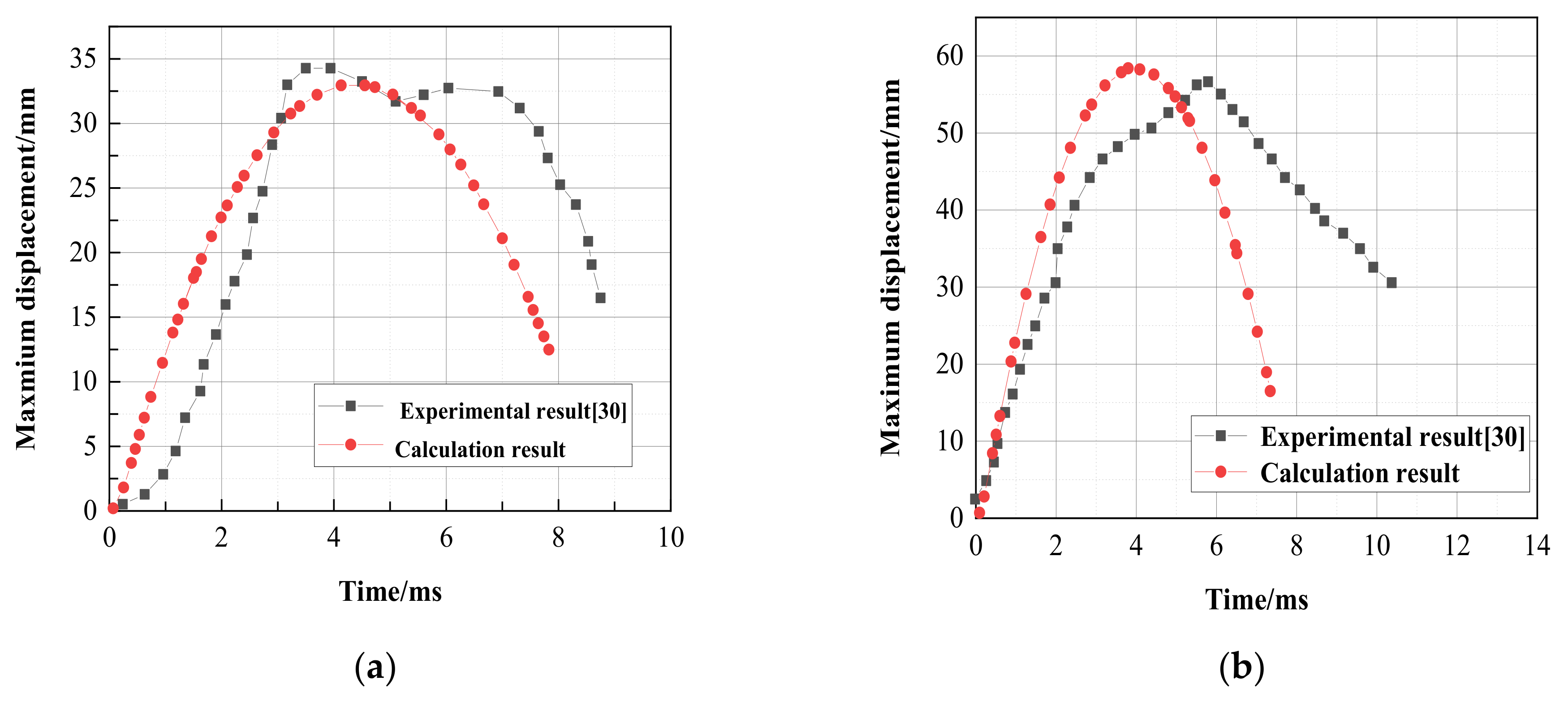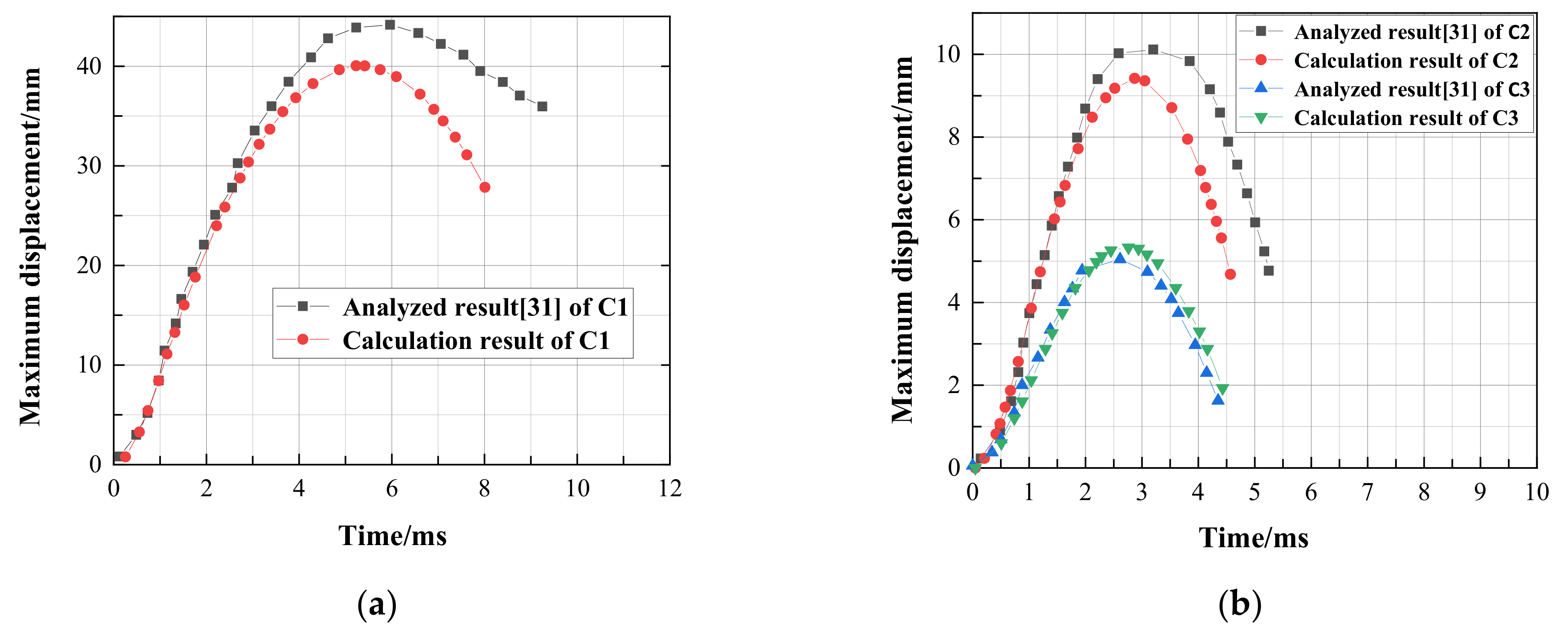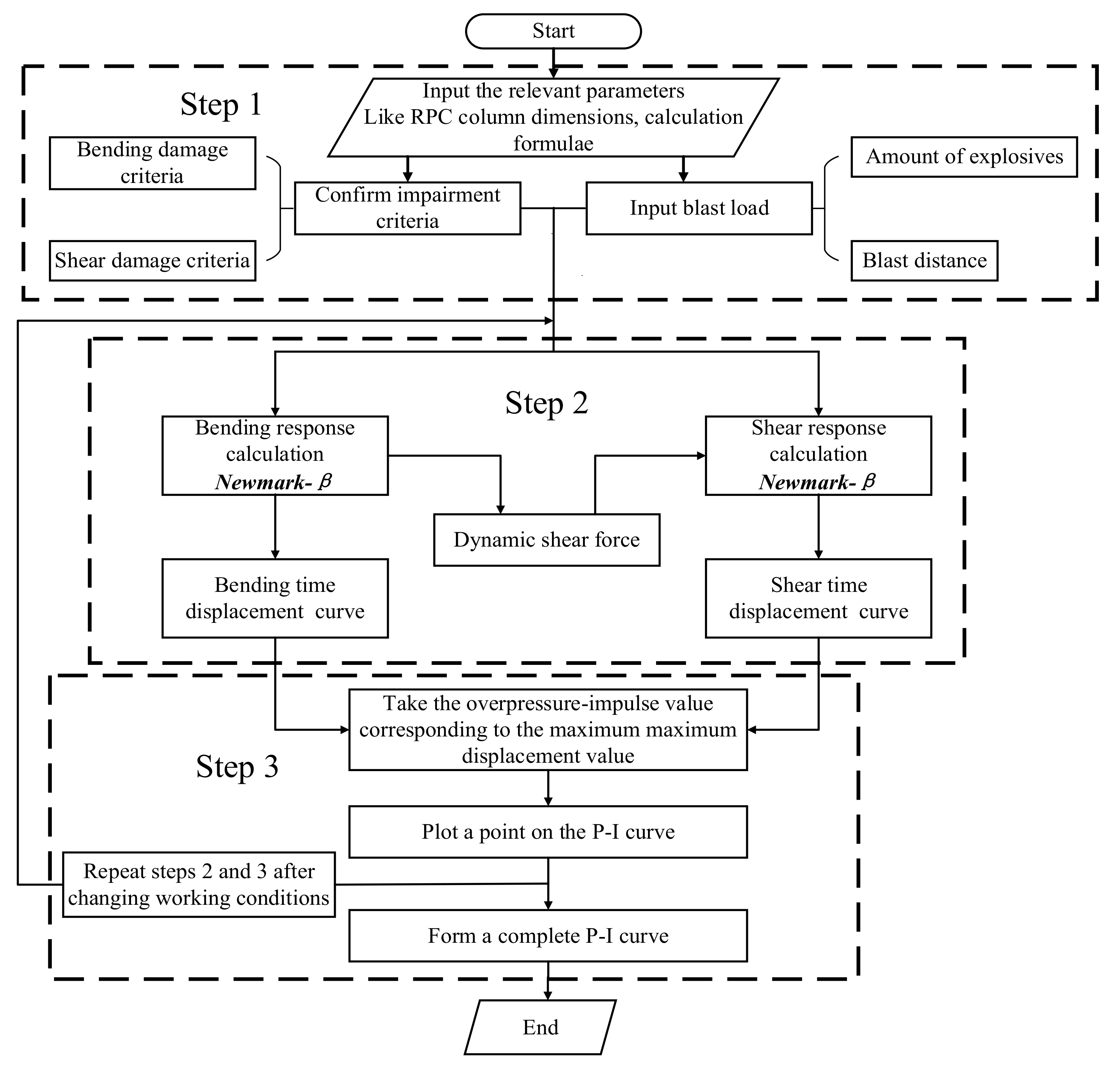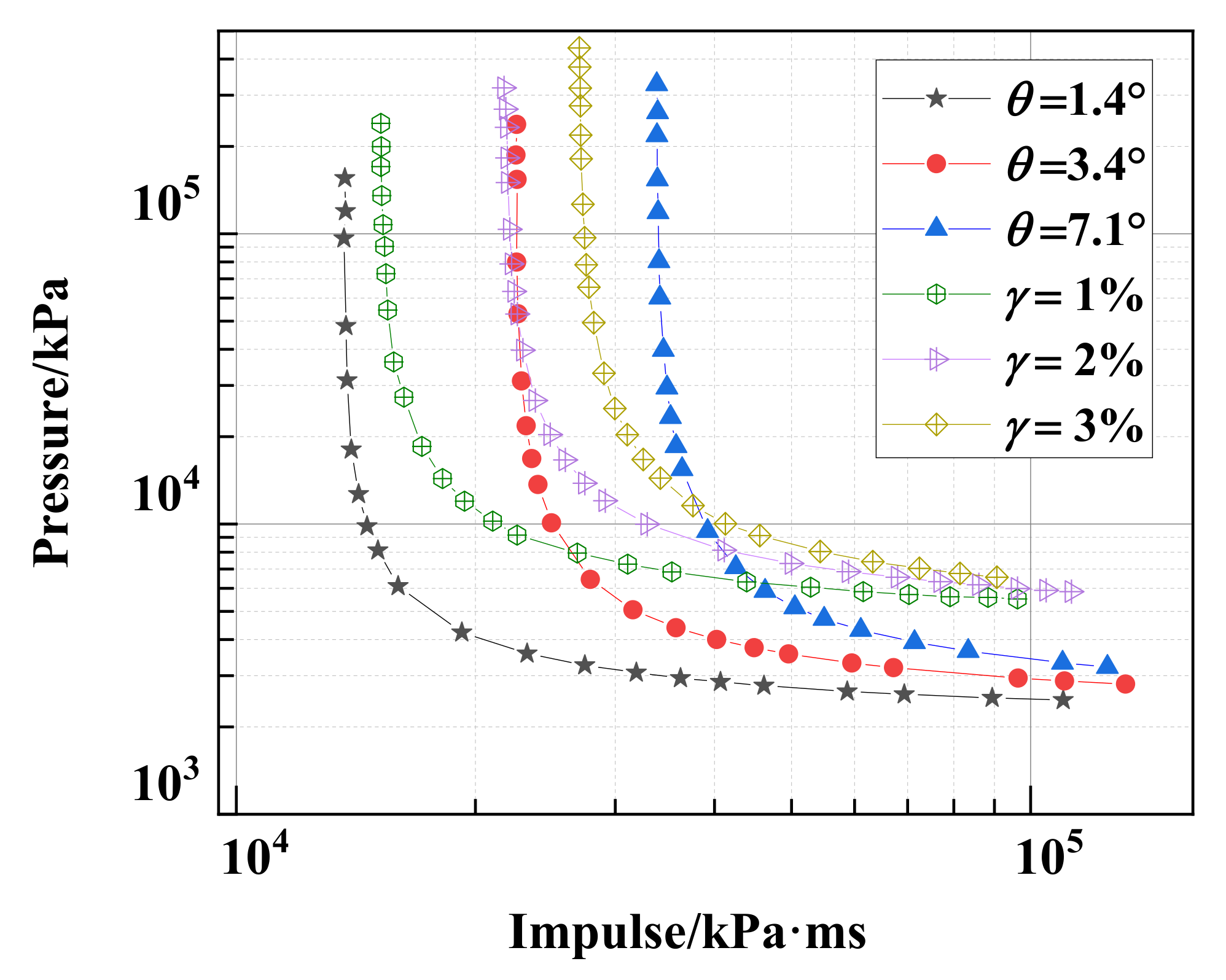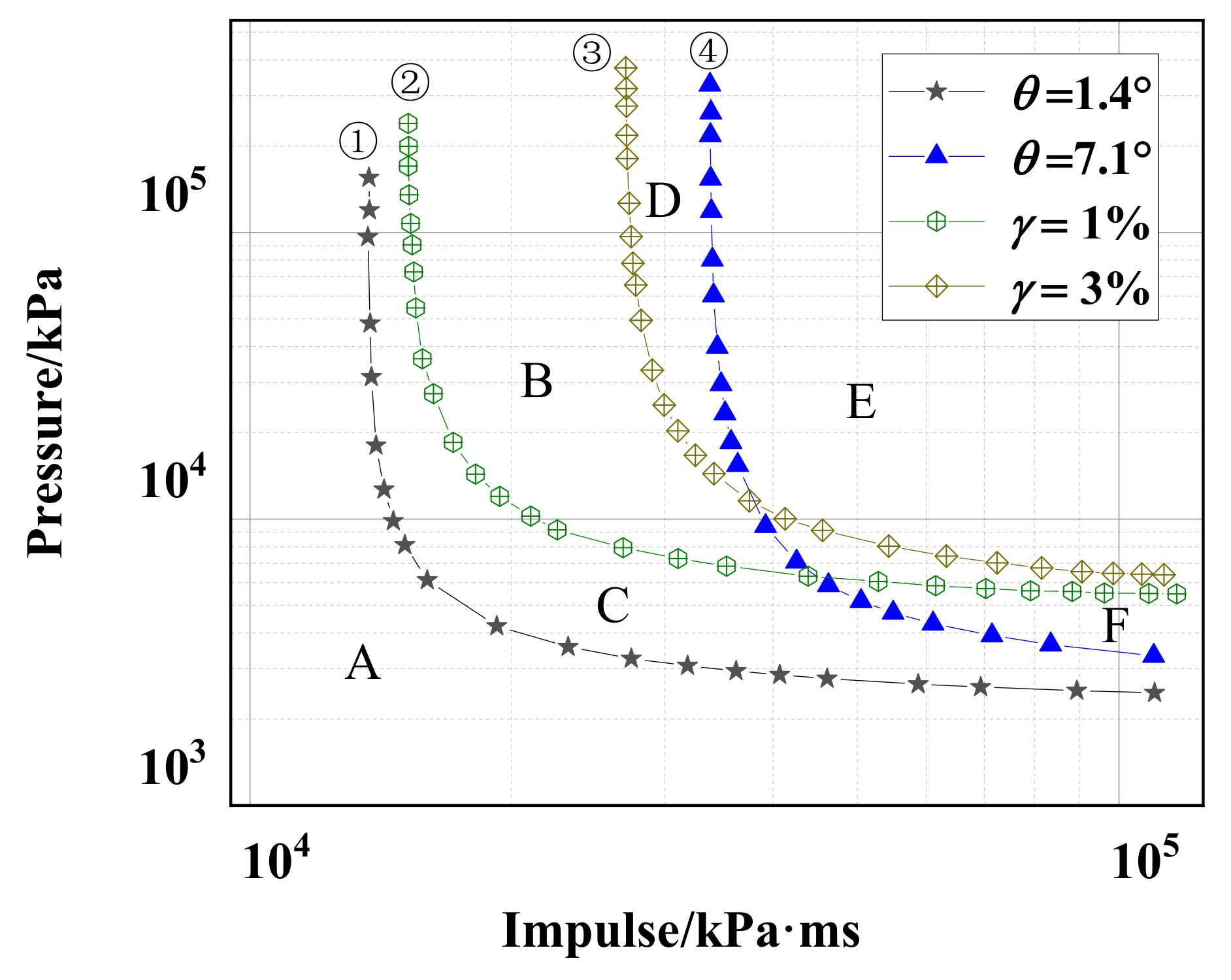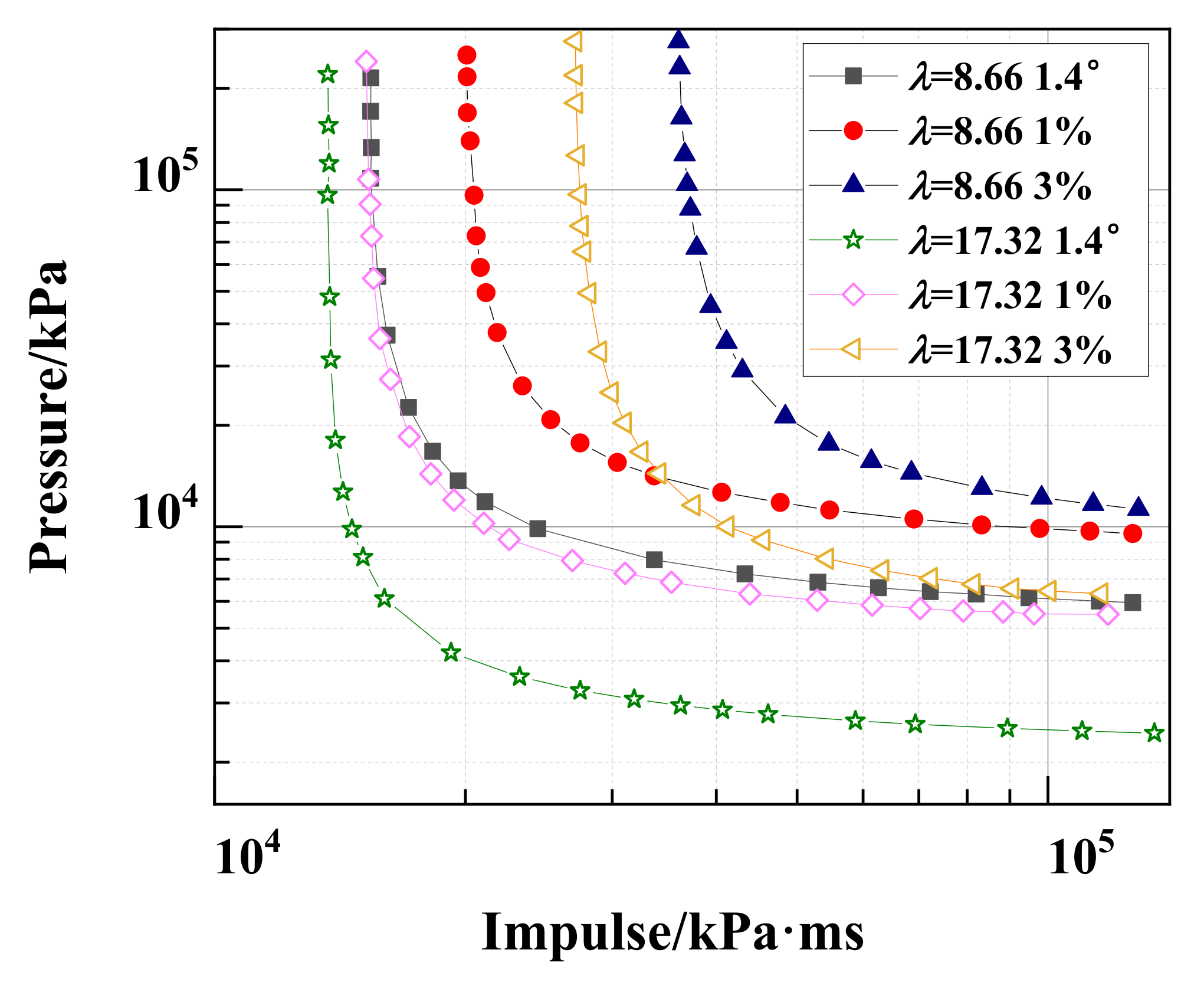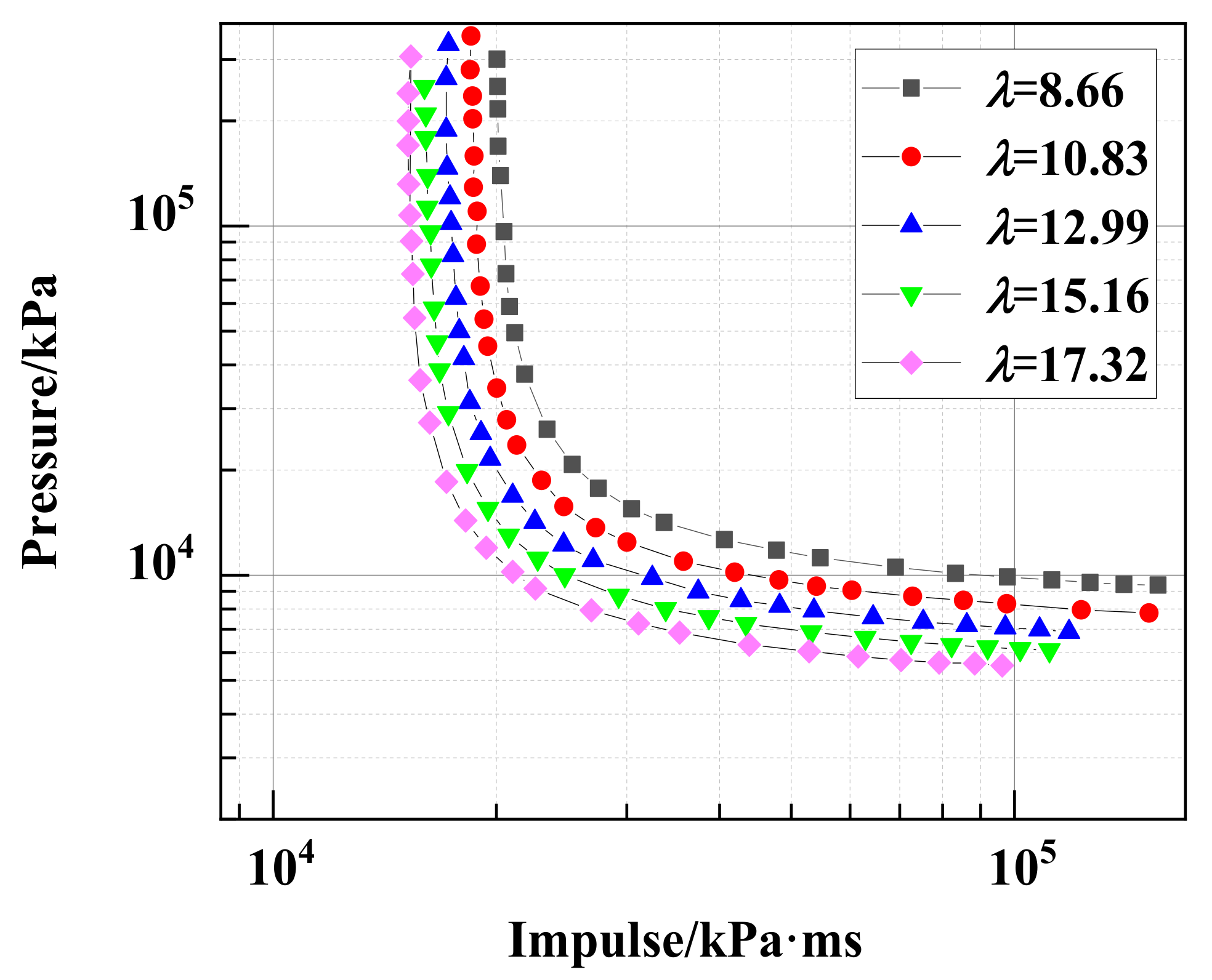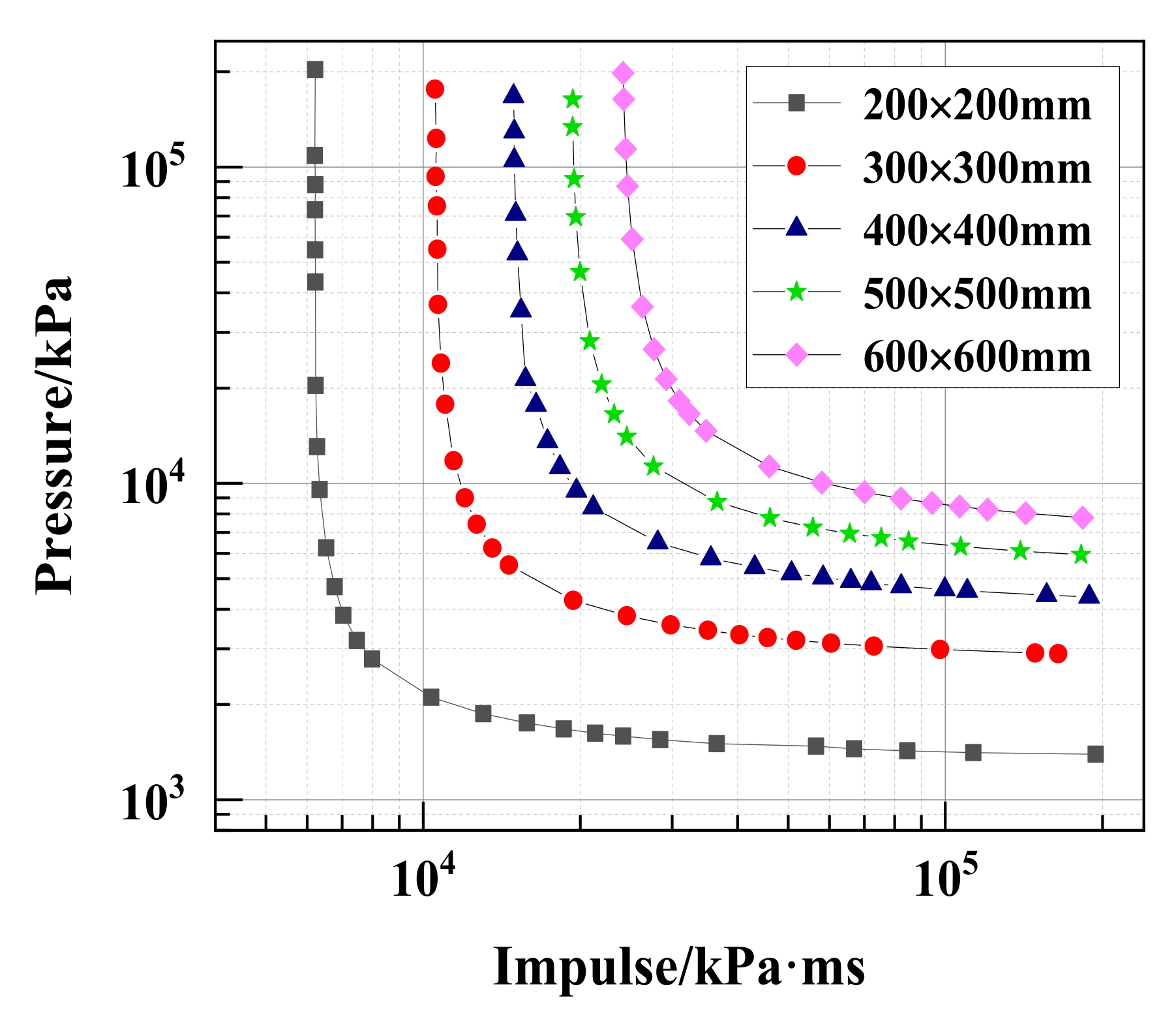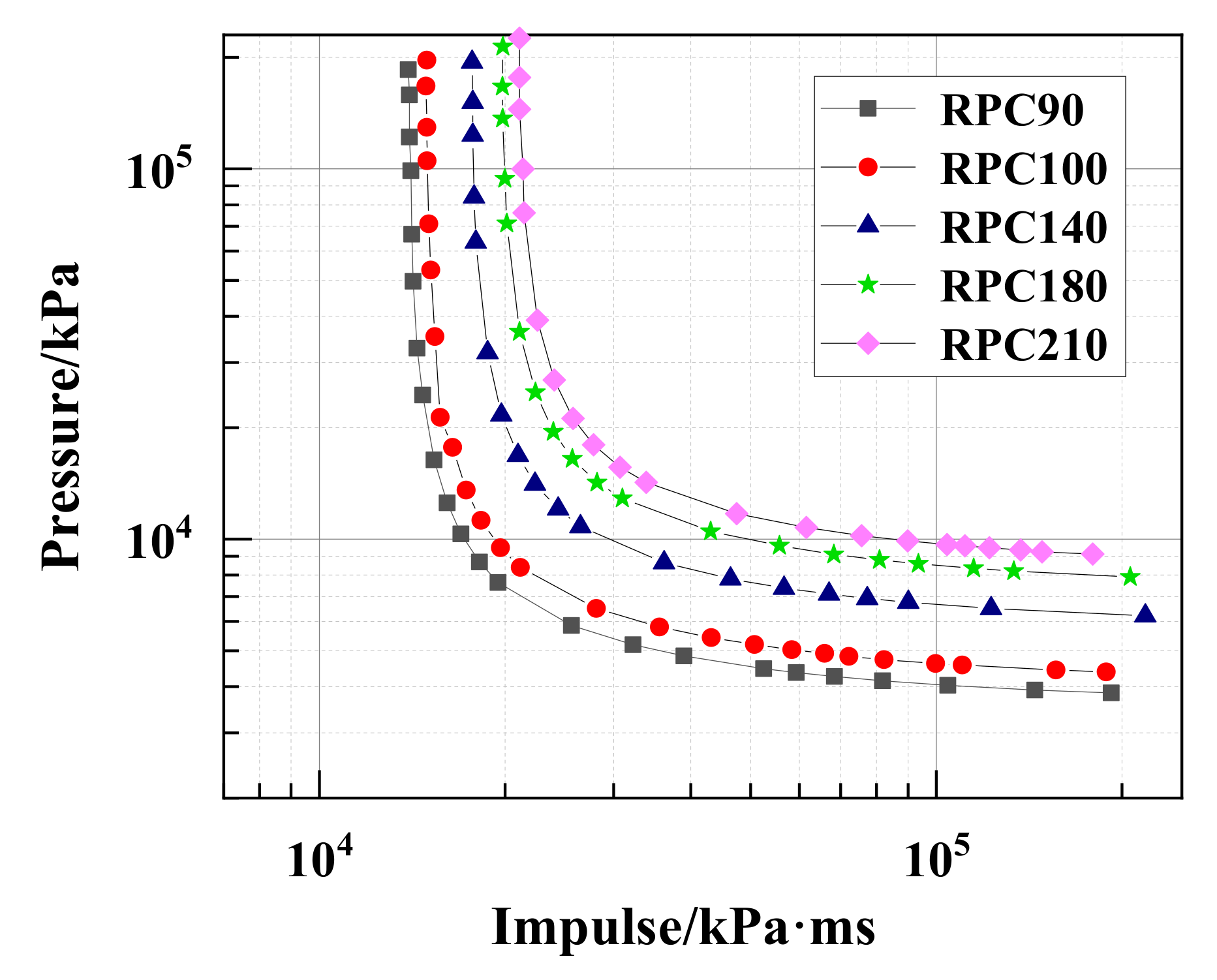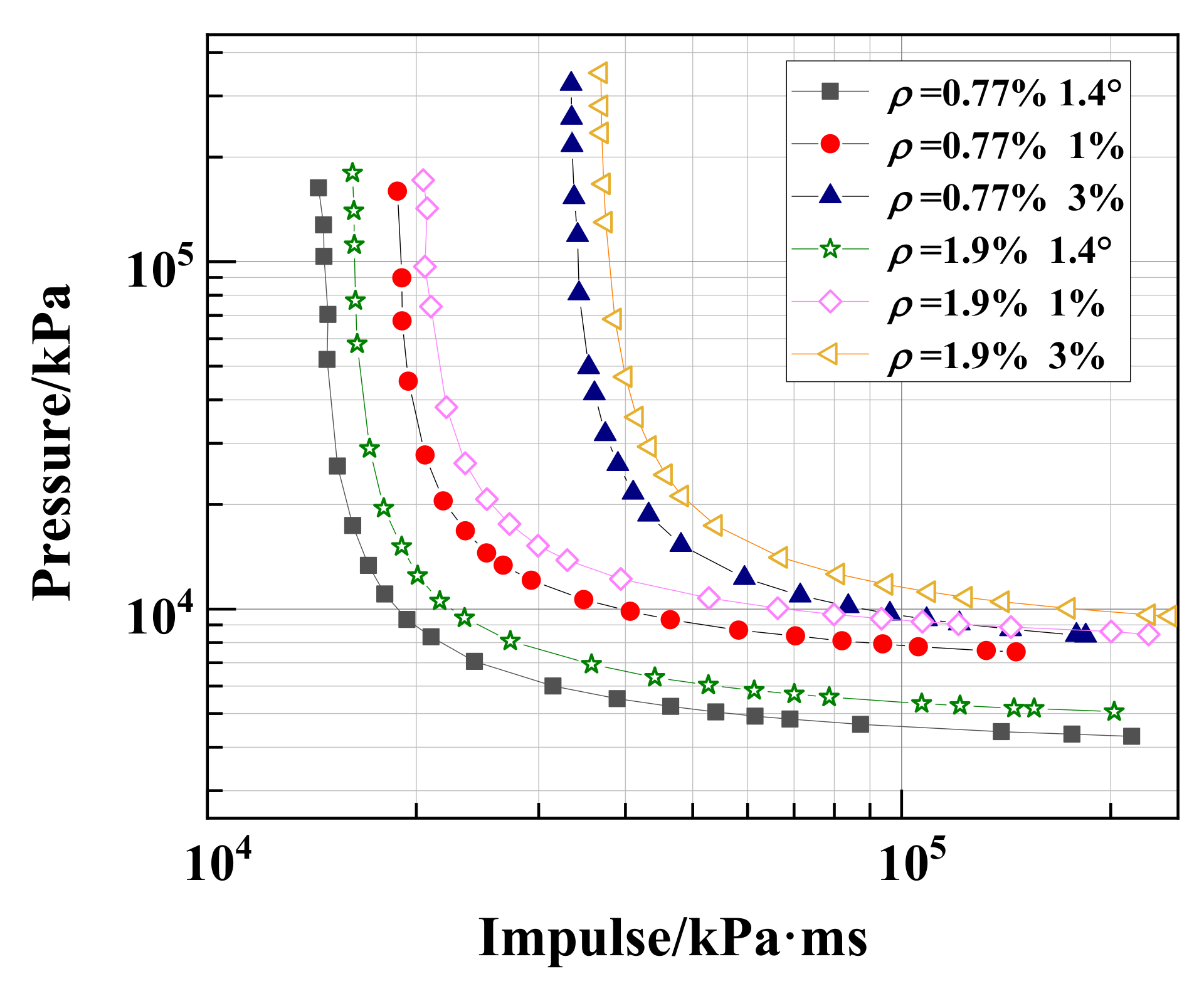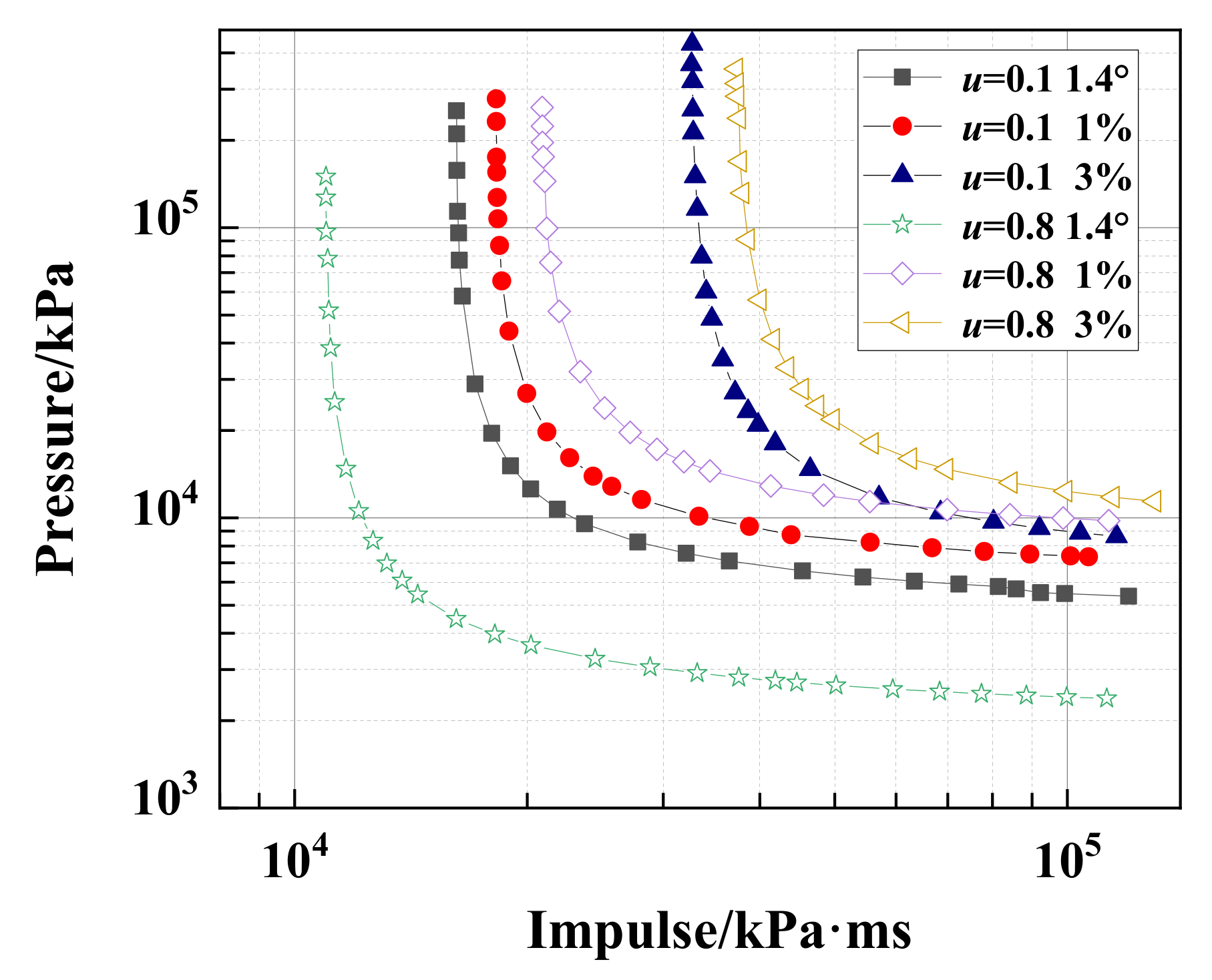1. Introduction
During the last few decades, many explosions worldwide have posed a serious threat to public safety and building structures. Thus, protecting buildings and occupants’ lives, while satisfying societal development needs in the future has become of paramount importance. RPC structures have started getting focus and significant attention from scientists and civil engineering experts. The use and research of RPC are increasing day by day in important buildings. Moreover, the column is an important vertical load-bearing component. Its destruction under the blast loading destroys the superstructure, and may even lead to the progressive collapse of the entire building [
1]. Therefore, the RPC column may bring some changes in research. It is imperative to study the dynamic response of the RPC column under blast loading.
Scientists across the globe have conducted extensive research on the dynamic behavior of RPC materials and components lately and achieved valuable results. Cao et al. [
2] investigated the RPC dynamic compression model, and a dynamic compression model of RPC at elevated temperature was proposed. Yi et al. [
3] studied the blast resistance of ultra-high-strength concrete (UHSC) and RPC. The results show that the splitting tensile strength of RPC was higher than that of UHSC, and excellent energy absorption was obtained in short steel fibers RPC. For better analysis of the impact resistance of the materials, the Spilt Hopkinson Pressure Bar (SHPB) is often used to study the dynamic response. Hou et al. [
4] used SHPB to test three kinds of steel fiber RPC (SFRPC) with 0%, 2%, and 5% steel fibers and found that with increasing content of steel fiber, the energy absorption of RPC increased. Wang et al. [
5] used SHPB to study the influence of different steel fiber amounts in two-pulse sections of different thicknesses with dynamic strength and failure mode. It was demonstrated that the compressive strength of the RPC is related to the hydrostatic pressure. Wu et al. [
6] used SHPB to detect the dynamic differences between pure UHPC and two reinforced UHPC fibers (1.5% and 2%) under three different velocities. Results showed that the fibers can restrict the crack development under dynamic loading. Ren et al. [
7] used SHPB (∅74 mm) to perform dynamic compression and tensile tests on steel fiber RPC. It was shown that the dynamic compressive strength of RPC was increased with an increased strain rate. Jiao et al. [
8] examined the stress and strain, elastic modulus, strain rate sensitivity threshold, and damage mode of RPC with volume fractions of 0%, 3%, and 4% under impact load. The results found that the strain rate threshold of the material is 30
−1. Ju et al. [
9] used SHPB to analyze the stress transfer, failure rate, and energy dissipation characteristics of RPC with different fiber volumes and impact speeds. The general shape of the RPC stress-strain state was also determined.
Further, the blast resistance of RPC members has been studied. Fujikake et.al. [
10,
11] studied the impact response of RPC beams by drop hammer impact tests and static bending load tests. It was shown that the maximum mid-span deflection of the RPC beam increases proportionally as the height decreases. Kou et al. [
12] analyzed the impact resistance of three RPC and RC panels and found that the impact resistance of the RPC panels was significantly higher than that of the RC panels. Hou et al. [
13] combined numerical simulations and experimental control to create a method for estimating the dynamic response and damage of the steel fiber RPC slabs under blast loading. Li et al. [
14] used the overpressure-impulse (P-I) to study the damage response of RPC unidirectional slabs under blast loading and analyze the effect of slab width, load level, reinforcement rate, and RPC strength on the shape of the P-I curve and the asymptote.
Many researchers have extensively studied the theoretical calculation methods and dynamic performance of RPC materials, beams, slabs, and other components. Valuable results and findings have been obtained through these studies. However, due to the special behavior of columns in the load-bearing system of building structures, there are few reports on RPC columns, especially on the damage modes and assessment methods of RPC columns under dynamic loading. There is a large discrepancy between the dynamic response and damage assessment of RPC columns in terms of ease and accuracy.
Relevant researchers have carried out some tentative studies on the anti-blast performance of ultra-high-strength concrete columns (UHPC). Li et al. [
15] studied the field blasting test of the UHPC column formulated based on RPC. The static axial load test was also carried out on the post-explosion of the UHPC column and the damage degree of the column was analyzed by the P-I curve. However, the P-I curve was calculated based on reinforced concrete columns’ P-I curve formula by changing the concrete strength to UHPC strength directly. Due to the dynamic increase factor (
DIF) of RPC being smaller than concrete, the calculated P-I curve in [
15] will cause an unsafe result. Viet-Chinh Mai et al. [
16] used the ABAQUS to explore the dynamic response of UHPC column under explosion load. The influence of key parameters was analyzed, and finally, the P-I curve of the UHPC column according to the maximum loading capacity and residual loading capacity was calculated. However, the UHPC strength is not considered in the calculation of the P-I curve.
Previous research presented some useful information, but some important factors were not considered. The damage assessment P-I curve of the structure in the literature [
15,
16] needs to first determine the maximum loading capacity of the column and the residual loading capacity of the column after explosion through the test or simulation software, and then calculate the damage degree. This process increases the computing cycle. Therefore, a handy and accurate method is needed to determine the damage pattern and degree of damage to RPC columns. Currently, the ESDOF method can solve this problem well. In practical engineering, it is necessary to evaluate the peak response of the structure. Under the premise of ensuring accuracy, the difficulty and time of the calculation can be reduced.
In order to improve the problem and try the new research methods, this article presents the P-I diagram method to predict failure modes of RPC columns subjected to blast loading. The criteria and methods based on ESDOF to distinguish damage classification were proposed. A shear fracture criterion is introduced to the failure modes’ P-I diagram of columns. The dynamic direct shear model of RPC proposed is utilized. Further, the effects of cross-sectional dimension, RPC strength, longitudinal reinforcement ratio, slenderness ratio, and axial compression ratio on the shape and asymptote were determined. P-I diagrams are handy for the assessment of RPC columns, which can provide a valuable reference for improving the dynamic performance of RPC columns.
3. P-I Curve
P-I curve was first introduced in the Second World War to assess the damage degree of buildings under blast loadings. Subsequently, it was also refined to assess the damage to occupants and structures by experts and academics. Its basic form is shown in the paper [
35]. From left to right and top to bottom in the same curve could be divided into three parts. i.e., the impulsive load region, dynamic load region, and quasi-static load region.
P-I curve methods for predicting the intensity of RPC column damage can also be divided into three main steps as follows.
First step: Input calculation parameters and establish criteria
- (1)
Inputting model parameters such as column height, cross-sectional dimension, RPC strength, and longitudinal reinforcement rate et al. into the calculation program.
- (2)
Designing the explosive charge and blast distance, and calculating the overpressure and duration of the blast, the moment of inertia of the RPC column, stiffness, and other parameters.
- (3)
Establishing the bending-shear failure criteria of the RPC column.
Second step: Calculate the program and output the resulting curve
- (1)
Using the Newmark-β method to solve the bending-shear ESDOF equations of motion, the RPC column bending and shear displacement time curves can be obtained. The maximum displacement value also can be obtained.
- (2)
Obtaining the amount of explosive charge corresponding to the maximum displacement of the target, the blast distance, and the overpressure-impulse (P-I) value.
Last step: Plot the P-I curves
- (1)
The P-I value corresponding to the maximum displacement is recorded, and the corresponding point is plotted.
- (2)
Changing the blast condition and repeating the above process to obtain a complete P-I curve plot to predict the failure mode of the RPC column based on a specific parameter.
To facilitate the reader’s understanding of the P-I graph plotting process,
Figure 8 depicts the process of obtaining a complete P-I curve.
After calculating the values of the P-I corresponding to the blast loading, it is necessary to use the P-I curve to determine the classification and degree of damage under blast loading. The following section will define the typical RPC column parameters and calculate a typical RPC column bending-shear P-I curve. This step aims to reveal how to distinguish the classification and degree of damage to the structural components.
P-I Curve of Typical RPC Column
To pave the way for the parametric analysis in the next section, the parameters of the typical RPC column and its P-I curve are designed and calculated in this section. To make the numerical calculation results more evidence-based, the component dimension and internal reinforcement materials involved in this study refer to the material data of the test members in the paper [
14]. The specific parameters are shown in
Table 7. The P-I curves are shown in
Figure 9 and
Figure 10.
As shown in
Figure 10, the four curves can be seen. Within the four curves, ① and ② represent light and serious bending damage curves, whereas ③ and ④ represent light and serious shear damage curves. Four curves divide the diagram into six major segments, i.e., A, B, C, D, E, and F.
Each curve represents the critical value of the degree of damage. The points on either side of the curve represent the degree of completely different damage. For example, the points in region C have exceeded the lower limit of bending light damage, but not the lower limit of light shear damage. Therefore, C can be judged as a light-bending damage region. Similarly, F can be identified as a serious bending damage region. B can be judged as a light shear damage region. A and D are safe and serious shear damage regions, respectively. However, for region E, this scenario needs to be further divided into two cases based on the damage to the column support:
- (1)
If the column has reached shear failure before bending failure occurs, the column will have only shear failure;
- (2)
If the shear failure does not occur before bending damage, the column will have bending-shear failure.
In general, when the corresponding overpressure-impulse point is located on the curve, the damage to the structure is considered to be higher, which is the basic principle of the P-I curve assessment.
4. Effect of Parameters for P-I Curve
In order to reveal the influence of RPC column parameters on the shape of the P-I curve and its asymptote, the five key parameters, slenderness ratio, cross-sectional dimension, RPC strength, longitudinal reinforcement ratio, and axial compression ratio governing the dynamic response and failure mode of RPC columns under blast loading are selected. The range of parameters is determined by the basics of common constructions [
36,
37].
The comparative results of P-I curves and asymptotes under the key parameters are shown in the figures below. Four values in each key parameter are transformed to enhance diversity and reliability. In the following analysis of the P-I curve parameters, the curves corresponding to the smallest degree of damage in the bending-shear response P-I curves (bending damage, 1.4°; shear damage, 1%) are utilized in the quantitative analysis since every figure has a large number of curves.
4.1. Slenderness Ratio
In order to study the influence of the slenderness ratio of the RPC column on the P-I curve and asymptote, it is combined with the limited range of slenderness ratio
λ according to the guidelines of the “Code for the design of concrete structures” (GB50010-2010) [
38]. From the above code, it can be found that the
λ value of the square column should be between 8 and 28. In this section, the P-I curves of the five RPC columns, slenderness ratios are 8.66, 10.83, 12.99, 15.16, and 17.32, respectively, are investigated.
As shown in
Figure 11, with the increasing slenderness ratio, the P-I curves move down and left. Since the column changes from a short column to a slender column, the moment of inertia and stiffness of the cross-section are greatly reduced, and the flexural and shear capacity of the RPC column are reduced simultaneously. This change can make the RPC column prone to damage under dynamic loading. In addition, as the slenderness ratio increases, the shape of the bending response changes significantly.
As shown in
Figure 12 and
Figure 13, the shape of P-I curves for bending response changes significantly, and the impulse asymptote becomes closer.
Table 8 shows the regulation of overpressure-impulse asymptote in two classifications of damage. The results show that with the increasing slenderness ratio, the overpressure-impulse asymptote of bending response decreases by about 57.3% and 10.2%, respectively. The overpressure asymptote of the shear response decreases by about 41.1% and 37.9% as the slenderness ratio increases, and the impulse asymptote decreases about 23.7% and 24.7%.
In conclusion, as the slenderness ratio increases, the P-I curve asymptotes of bending-shear response both reduce to varying degrees. However, the overpressure asymptote of bending response is significantly affected. Combined with the characteristics of the P-I curve quasi-static load region, increasing the slenderness ratio may increase the degree of bending damage at mid-span. Reasonably, reducing the slenderness ratio may effectively enhance the bending capacity of the RPC column at mid-span under blast loading.
4.2. Cross-Sectional Dimension
Five cross-sectional dimensions (200 × 200 mm, 300 × 300 mm, 400 × 400 mm, 500 × 500 mm, and 600 × 600 mm) of RPC column were selected to investigate its effect on the shape and the asymptote of P-I curves for bending-shear damage.
As shown in
Figure 14, as the cross-sectional dimension increases from 200 × 200 mm to 600 × 600 mm, the P-I curves of bending-shear response both shift to the upper and right region. That means the overpressure-impulse asymptotes both increase at the same time. This is because the larger cross-sectional dimension results in a greater moment of inertia, which induces superior dynamic load resistance of the RPC column. In addition, with the change in cross-sectional dimension, the shape of the bending response P-I curves changes significantly.
As shown in
Figure 15 and
Figure 16, the overpressure-impulse asymptote of bending response increases uniformly as the cross-sectional dimensions increase, while the impulse asymptote of shear damage changes more than the overpressure asymptote.
Table 9 reveals the regulation of overpressure-impulse asymptotes in two classifications of damage. The results show that as the cross-sectional dimension increases, the overpressure-impulse asymptote of bending response increases by 4.2 and 2.9 times (calculated by columns 2 and 3 in
Table 9), respectively. In addition, the overpressure asymptotes of shear response increase by 0.5 and 0.6 times more than before (calculated by columns 4 and 6 in
Table 9). The impulse asymptotes increase by 2.64 and 2.6 times, respectively, (calculated by columns 7 and 9 in
Table 9).
In summary, the change in cross-sectional dimensions primarily affects the overpressure asymptote of the bending response. However, for the shear response, the change in the impulse asymptote is much greater than the overpressure asymptote. Combined with the impulse and quasi-static load region characteristics, increasing cross-sectional dimension can effectively improve the bending capacity at mid-span and the shear capacity at support subjected to blast loading. It signifies that increasing the cross-sectional dimension within a reasonable range can significantly enhance the comprehensive anti-blast performance of the RPC column.
4.3. RPC Strength
RPC is increasingly used in buildings because of its high strength, toughness, and durability. In this study, numerical simulations are used to investigate the effect of RPC material strength on the shape and the asymptote of the P-I curve for different damage classifications. Five RPC strengths (the standard values of RPC compressive strength), 90 MPa, 100 MPa, 140 MPa, 180 MPa, and 210 MPa, are selected for investigation. Mechanical properties parameter values of RPC have been summarized [
39]. The Mechanical properties of RPC in the simulation are listed in
Table 10.
As shown in
Figure 17, it is found that as the RPC strength increases, the P-I curve of bending damage shifts to the upper right area, whereas the P-I curve of shear damage shifts to the lower left. In addition, as the change of RPC strength, P-I curves of bending-shear damage in the quasi-static load region become closer to each other. The curves of the same degree of damage for different RPC strengths in the shear response impulse load region almost overlap. This phenomenon occurs possibly because increasing RPC strength does not, to a certain extent, result in a significant increase in the shear capacity of the column at the supports. However, increasing RPC strength will, to a certain extent, result in brittle damage at support and reduce the shear capacity of the column.
As shown in
Figure 18 and
Figure 19, with the increase in RPC strength, the changing magnitude of the overpressure-impulse asymptote of the bending response is greater than the shear response. It indicates that increasing RPC strength primarily enhances the bending capacity of the component.
Table 11 shows the pattern of overpressure-impulse asymptotes in two damage classifications. The results show that as the RPC strength increases from 90 MPa to 210 MPa, the overpressure-impulse asymptote of bending response increases by 1.32 and 0.51 times more than before (calculated in columns 2 and 3 in
Table 11). Further, the overpressure asymptote of shear response increases by 0.35 and 0.34 times (calculated by columns 4 and 6 in
Table 11), whereas the impulse asymptote increases by 0.12 and 0.11 times than before (calculated by columns 5 and 7 in
Table 11), respectively.
In summary, as the RPC strength increases from 90 MPa to 210 MPa, the overpressure-impulse asymptote of bending response and shear response become larger, but the shear response has a relatively smaller magnitude. Increasing RPC strength mainly affects the overpressure asymptote for P-I curves of bending-shear response. Combined with the features of quasi-static load region, increasing RPC strength, for mid-span or support of RPC column, both could improve the anti-blast performance under the explosion. In other words, the use of higher strength RPC can effectively enhance the comprehensive anti-blast performance of RPC columns.
4.4. Longitudinal Reinforcement Ratio
In order to study the effect of longitudinal reinforcement ratio on P-I curves and asymptotes, according to the “Code for design of concrete structures” (GB50010-2010) [
38], five longitudinal reinforcement ratios, 0.77%, 1.01%, 1.3%, 1.6%, and 1.9%, were calculated and analyzed.
As shown in
Figure 20, P-I curves of bending-shear damage shift to the upper right region as the longitudinal reinforcement ratio increases from 0.77% to 1.9%. This trend indicates overpressure-impulse asymptotes both increasing. Because changing the number of longitudinal bars and diameters increase the longitudinal reinforcement ratio and increases the number of hoop reinforcement and minimum diameter. These variations increase the bending-shear capacity of the RPC column.
As shown in
Figure 21 and
Figure 22, the increasing longitudinal reinforcement ratio both affects the P-I curve of bending-shear response, but the extent is different.
Table 12 reveals the trend of the overpressure-impulse asymptote in two damage classifications. The results show that as the longitudinal reinforcement ratio increases from 0.77% to 1.9%, the overpressure asymptote of bending response increases by about 17.8% (calculated by column 2 in
Table 12), while the impulse asymptote increases by about 12% than before (calculated by column 3 in
Table 12). However, the overpressure asymptote of shear response increases by about 12.8% and 8.8% (calculated by columns 4 and 6 in
Table 12), and the impulse asymptote increases by about 13.8% and 10.3%, respectively, (calculated by columns 5 and 7 in
Table 12).
In summary, the effect of increasing the longitudinal reinforcement ratio on the bending response is greater than the shear response. The change of longitudinal reinforcement ratio mainly affects the overpressure asymptote. Combined with the characteristics of the quasi-static load region, increasing the longitudinal reinforcement ratio of the RPC column can effectively improve the bending capacity at mid-span under the blast loading. In other words, reasonably increasing the longitudinal reinforcement ratio of RPC columns can resist blast loading at mid-span.
4.5. Axial Compression Ratio
To examine the effect of the axial compression ratio on the shape and the asymptote of the P-I curve, five RPC columns with different axial compression ratios, 0.1, 0.3, 0.5, 0.7, and 0.8, were studied, following the upper limit of column axial compression ratio in the Chinese Code “Seismic design of buildings” (GB50011-2011) [
41].
As the axial compression ratio increases in
Figure 23, the P-I curve of bending response shifts down and left, but the shear response curve shifts toward up and right. This phenomenon indicates that increasing the axial compression ratio could significantly affect the bending capacity of the RPC column.
As shown in
Figure 23 and
Figure 24, increasing the axial compression ratio could decrease the bending response asymptote, but increase the shear response asymptote. To better illustrate the variation of the asymptote,
Table 13 reveals the regulation of axial compression ratio for two classifications of damage. The results show that as the axial compression ratio increases from 0.1 to 0.8, the overpressure asymptote of the bending response decreases by about 55.5% (calculated by column 2 in
Table 13), and the impulse asymptote decreases by about 32.2% (calculated by column 3 in
Table 13). However, for the shear response, as shown in
Figure 25, as the axial compression ratio increases from 0.1 to 0.8, the overpressure asymptote increases about 33.1% and 32% (calculated by columns 4 and 6 in
Table 13), and the impulse asymptote increases about 14.6% and 2.9%, (calculated by columns 5 and 7 in
Table 13), respectively.
In summary, increasing the axial compression ratio significantly reduces the bending capacity of the RPC column. By combining with the characteristics of the load region within the P-I curve, it is inferred that reducing the axial compression ratio can effectively improve the bending capacity of the RPC column at mid-span under the blast load, i.e., reasonably reducing the axial compression ratio may effectively resist bending damage at mid-span under the blast loading.
